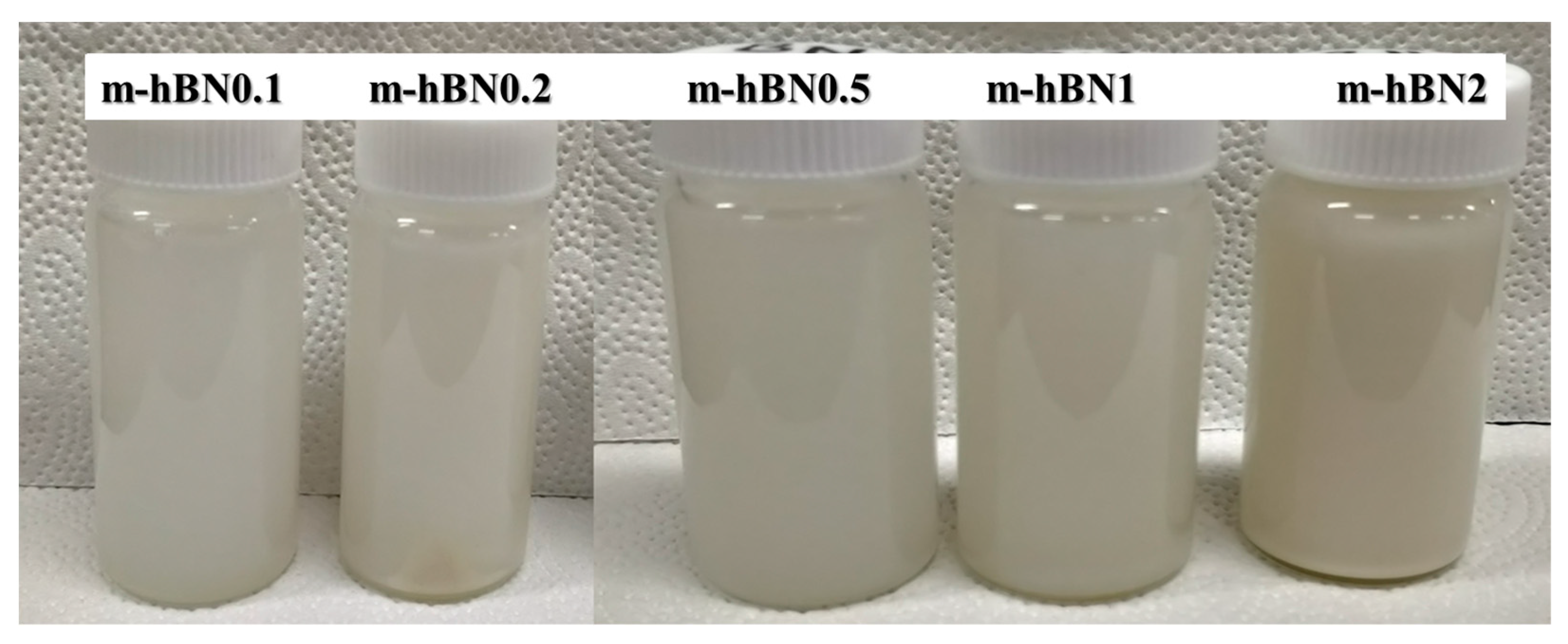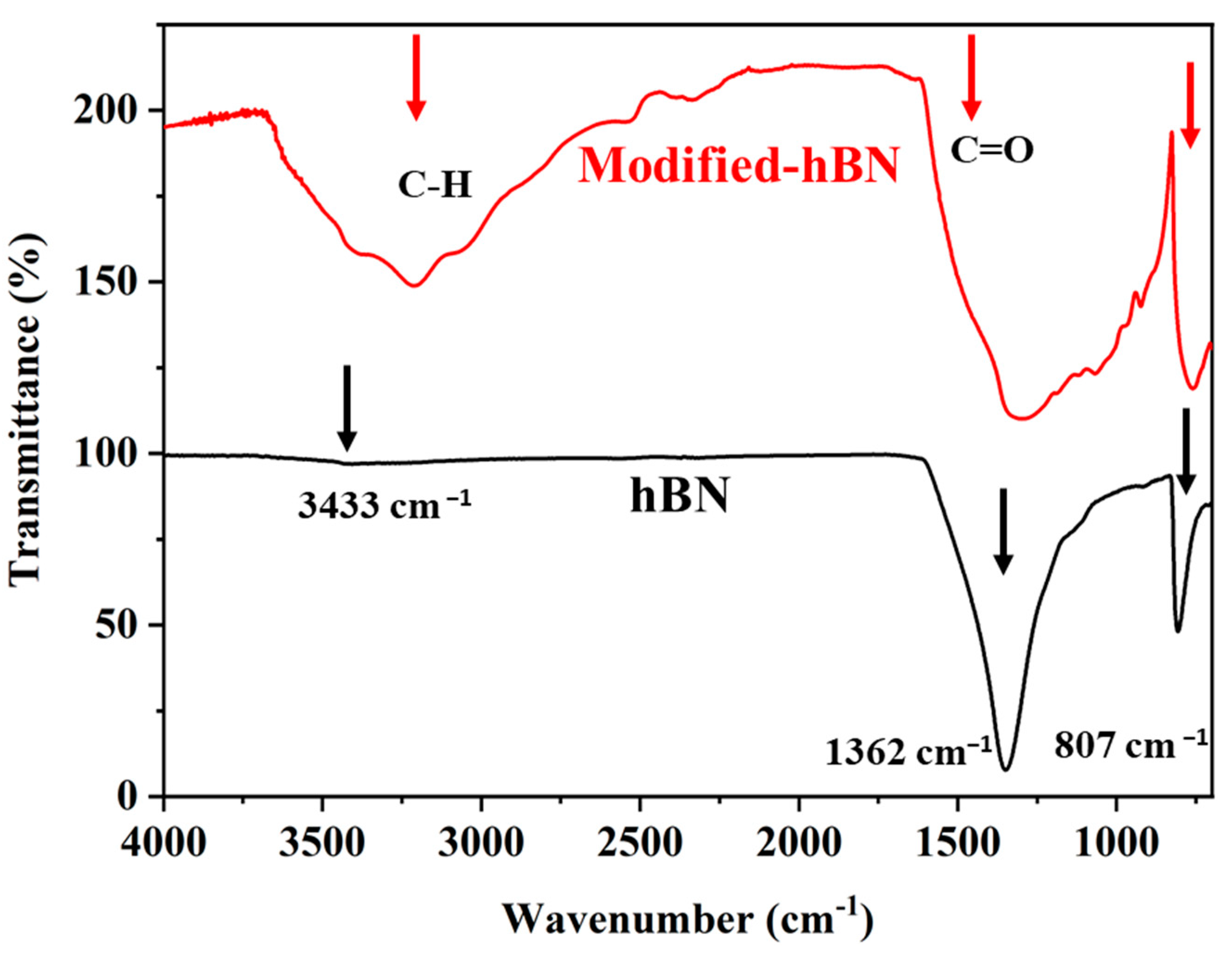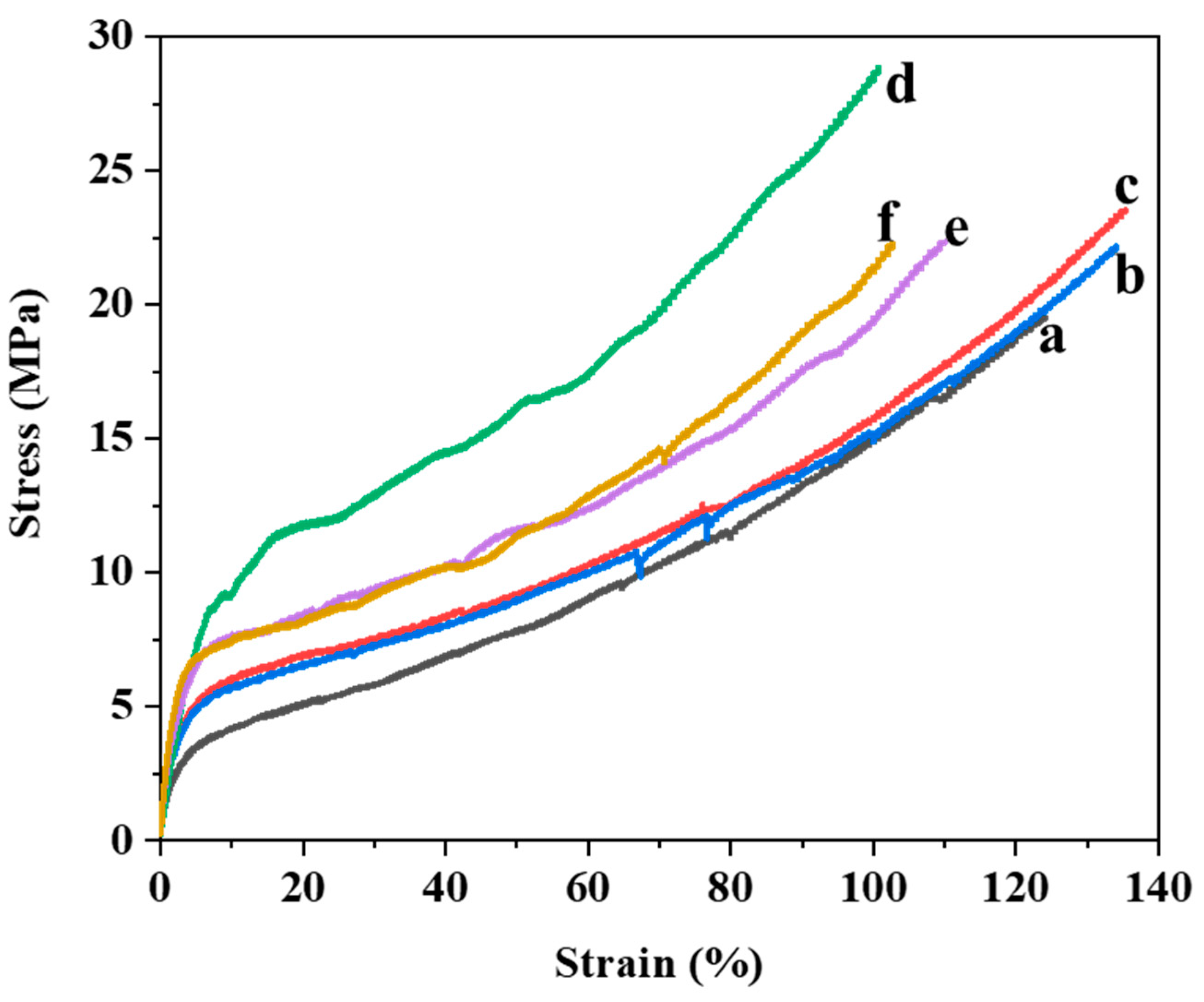Optimization of UV-Curable Polyurethane Acrylate Coatings with Hexagonal Boron Nitride (hBN) for Improved Mechanical and Adhesive Properties
Abstract
1. Introduction
2. Experimental
2.1. Materials
2.2. Synthesis of hBN Nanosheets
2.3. Functionalization of hBN Nanosheets
2.4. Fabrication of m-hBN/PUA Nanocomposites
- The m-hBN nanoplatelets were added to IBOA and blended using a vortex mixer.
- The appropriate amount of PUA and photocatalyst were then added to the mixture, which was blended for 1 h.
- After mixing, the blend was subjected to ultrasonication for 2 h and subsequently mixed again for 1 h using a vortex mixer.
2.5. Characterizations
3. Results and Discussions
4. Conclusions
Supplementary Materials
Author Contributions
Funding
Institutional Review Board Statement
Data Availability Statement
Conflicts of Interest
References
- Kim, K.; Kim, M.; Kim, J. Fabrication of UV-Curable Polyurethane Acrylate Composites Containing Surface-Modified Boron Nitride for Underwater Sonar Encapsulant Application. Ceram. Int. 2014, 40, 10933–10943. [Google Scholar] [CrossRef]
- Gavande, V.; Im, D.; Lee, W.K. Development of Highly Transparent UV-Curable Nylon 6 Nanofiber-Reinforced Polyurethane Acrylate Nanocomposite Coatings for Pre-Coated Metals. J. Appl. Polym. Sci. 2021, 138, 50614. [Google Scholar] [CrossRef]
- Hu, Y.; Shang, Q.; Bo, C.; Jia, P.; Feng, G.; Zhang, F.; Liu, C.; Zhou, Y. Synthesis and Properties of UV-Curable Polyfunctional Polyurethane Acrylate Resins from Cardanol. ACS Omega 2019, 4, 12505–12511. [Google Scholar] [CrossRef]
- Jiao, Z.; Wang, X.; Yang, Q.; Wang, C. Modification and Characterization of Urethane Acrylate Oligomers Used for UV-Curable Coatings. Polym. Bull. 2017, 74, 2497–2511. [Google Scholar] [CrossRef]
- Wang, X.; Xing, W.; Song, L.; Yu, B.; Hu, Y.; Yeoh, G.H. Preparation of UV-curable functionalized graphene/polyurethane acrylate nanocomposite with enhanced thermal and mechanical behaviors. React. Funct. Polym. 2013, 73, 854–858. [Google Scholar] [CrossRef]
- Liu, R.; Zhang, X.; Zhu, J.; Liu, X.; Wang, Z.; Yan, J. UV-Curable Coatings from Multiarmed Cardanol-Based Acrylate Oligomers. ACS Sustain. Chem. Eng. 2015, 3, 1313–1320. [Google Scholar] [CrossRef]
- Choi, W.-C.; Gavande, V.; Kim, D.-Y.; Lee, W.-K. Study on Press Formability and Properties of UV-Curable Polyurethane Acrylate Coatings with Different Reactive Diluents. Polymers 2023, 15, 880. [Google Scholar] [CrossRef]
- Agnol, L.D.; Dias, F.T.G.; Ornaghi Jr, H.L.; Sangermano, M.; Bianchi, O. UV-Curable Waterborne Polyurethane Coatings: A State-of-the-Art and Recent Advances Review. Prog. Org. Coat. 2021, 154, 106156. [Google Scholar] [CrossRef]
- Fu, J.; Yu, H.; Wang, L.; Lin, L.; Khan, R.U. Preparation and Properties of UV-Curable Hyperbranched Polyurethane Acrylate Hard Coatings. Prog. Org. Coat. 2020, 144, 105635. [Google Scholar] [CrossRef]
- Xiang, H.; Wang, X.; Lin, G.; Xi, L.; Yang, Y.; Lei, D.; Dong, H.; Su, J.; Cui, Y.; Liu, X. Preparation, Characterization and Application of UV-Curable Flexible Hyperbranched Polyurethane Acrylate. Polymers 2017, 9, 552. [Google Scholar] [CrossRef]
- Yu, B.; Wang, X.; Xing, W.; Yang, H.; Song, L.; Hu, Y. UV-Curable Functionalized Graphene Oxide/Polyurethane Acrylate Nanocomposite Coatings with Enhanced Thermal Stability and Mechanical Properties. Ind. Eng. Chem. Res. 2012, 51, 14629–14636. [Google Scholar] [CrossRef]
- Fu, J.; Wang, L.; Yu, H.; Haroon, M.; Haq, F.; Shi, W.; Wu, B.; Wang, L. Research Progress of UV-Curable Polyurethane Acrylate-Based Hardening Coatings. Prog. Org. Coat. 2019, 131, 82–99. [Google Scholar] [CrossRef]
- Gültekin, K.; Uğuz, G.; Özel, A. Improvements of the Structural, Thermal, and Mechanical Properties of Structural Adhesive with Functionalized Boron Nitride Nanoparticles. J. Appl. Polym. Sci. 2021, 138, 50491. [Google Scholar] [CrossRef]
- Yu, Q.; Zhang, Z.; Tan, P.; Zhou, J.; Ma, X.; Shao, Y.; Wei, S.; Gao, Z. Siloxane-Modified UV-Curable Castor-Oil-Based Waterborne Polyurethane Superhydrophobic Coatings. Polymers 2023, 15, 4588. [Google Scholar] [CrossRef]
- Mistry, M.; Prajapati, V.; Dholakiya, B.Z. Redefining Construction: An In-Depth Review of Sustainable Polyurethane Applications. J. Polym. Environ. 2024, 32, 3448–3489. [Google Scholar] [CrossRef]
- Vardanyan, V.; Poaty, B.; Chauve, G.; Landry, V.; Galstian, T.; Riedl, B. Mechanical Properties of UV-Waterborne Varnishes Reinforced by Cellulose Nanocrystals. J. Coat. Technol. Res. 2014, 11, 841–852. [Google Scholar] [CrossRef]
- Al-Shannaq, R.; Farid, M.M. A Novel Graphite-PCM Composite Sphere with Enhanced Thermo-Physical Properties. Appl. Therm. Eng. 2018, 142, 401–409. [Google Scholar] [CrossRef]
- Fang, H.; Bai, S.-L.; Wong, C.P. “White Graphene”—Hexagonal Boron Nitride Based Polymeric Composites and Their Application in Thermal Management. Compos. Commun. 2016, 2, 19–24. [Google Scholar] [CrossRef]
- Yang, Y.; Peng, Y.; Saleem, M.F.; Chen, Z.; Sun, W. Hexagonal Boron Nitride on III–V Compounds: A Review of the Synthesis and Applications. Materials 2022, 15, 4396. [Google Scholar] [CrossRef]
- Naclerio, A.E.; Kidambi, P.R. A Review of Scalable Hexagonal Boron Nitride (h-BN) Synthesis for Present and Future Applications. Adv. Mater. 2023, 35, 2207374. [Google Scholar] [CrossRef] [PubMed]
- Wang, J.; Ma, F.; Sun, M. Graphene, Hexagonal Boron Nitride, and Their Heterostructures: Properties and Applications. RSC Adv. 2017, 7, 16801–16822. [Google Scholar] [CrossRef]
- Yu, C.; Zhang, J.; Tian, W.; Fan, X.; Yao, Y. Polymer Composites Based on Hexagonal Boron Nitride and Their Application in Thermally Conductive Composites. RSC Adv. 2018, 8, 21948–21967. [Google Scholar] [CrossRef] [PubMed]
- Zhang, Q.; Huang, C.; Wang, H.; Hu, M.; Li, H.; Liu, X. UV-Curable Coating Crosslinked by a Novel Hyperbranched Polyurethane Acrylate with Excellent Mechanical Properties and Hardness. RSC Adv. 2016, 6, 107942–107950. [Google Scholar] [CrossRef]
- Wattanakul, K.; Manuspiya, H.; Yanumet, N. Thermal Conductivity and Mechanical Properties of BN-Filled Epoxy Composite: Effects of Filler Content, Mixing Conditions, and BN Agglomerate Size. J. Compos. Mater. 2011, 45, 1967–1980. [Google Scholar] [CrossRef]
- Bayır, S.; Semerci, E.; Bedri, T.E. Preparation of Novel Thermal Conductive Nanocomposites by Covalent Bonding between Hexagonal Boron Nitride Nanosheet and Well-Defined Polymer Matrix. Compos. Part A Appl. Sci. Manuf. 2021, 146, 106406. [Google Scholar] [CrossRef]
- Yang, G.; Zhang, X.; Shang, Y.; Xu, P.; Pan, D.; Su, F.; Ji, Y.; Feng, Y.; Liu, Y.; Liu, C. Highly Thermally Conductive Polyvinyl Alcohol/Boron Nitride Nanocomposites with Interconnection Oriented Boron Nitride Nanoplatelets. Compos. Sci. Technol. 2021, 201, 108521. [Google Scholar] [CrossRef]
- Mahmood, S.; Khan, A.; Kant, C.; Chu, C.W.; Katiyar, M.; Lin, H. Transparent, Stretchable, and Self-Healable Gas Barrier Films with 2D Nanoplatelets for Flexible Electronic Device Packaging Applications. Adv. Mater. Interfaces 2023, 10, 2202093. [Google Scholar] [CrossRef]
- Misra, D.; Nemane, V.; Mukhopadhyay, S.; Chatterjee, S. Effect of HBN and SiC Addition on Laser Assisted Processing of Ceramic Matrix Composite Coatings. Ceram. Int. 2020, 46, 9758–9764. [Google Scholar] [CrossRef]
- Che, Y.; Liu, C.; Li, N.; Guo, W.; Xi, M.; Zhang, S.; Wang, Z. UV Curing Polyurethane—Acrylate Composites as Full Filling Thermal Interface Materials. N. J. Chem. 2022, 46, 7979–7986. [Google Scholar] [CrossRef]
- Liu, H.; Zhang, H.; Peng, C.; Ren, S.; Yuan, C.; Luo, W.; Chen, G.; He, F.; Dai, L. UV-Curable Waterborne Polyurethane Dispersions Modified with a Trimethoxysilane End-Capping Agent and Edge-Hydroxylated Boron Nitride. J. Coat. Technol. Res. 2019, 16, 1479–1492. [Google Scholar] [CrossRef]
- Oh, S.; Gavande, V.; Lee, W.-K. Synthesis and Characteristics of Cardanol-Based Acrylates as Reactive Diluents in UV-Curing Coatings. Mol. Cryst. Liq. Cryst. 2023, 760, 68–75. [Google Scholar] [CrossRef]
- Queiroz, S.M.; Medeiros, F.S.; de Vasconcelos, C.K.B.; Silva, G.G. H-BN Nanosheets Obtained by Mechanochemical Processes and Its Application in Lamellar Hybrid with Graphene Oxide. Nanotechnology 2021, 33, 35714. [Google Scholar] [CrossRef] [PubMed]
- Magaletti, F.; Prioglio, G.; Giese, U.; Barbera, V.; Galimberti, M. Hexagonal Boron Nitride as Filler for Silica-Based Elastomer Nanocomposites. Nanomaterials 2023, 14, 30. [Google Scholar] [CrossRef] [PubMed]
- Sahoo, K.R.; Sharma, R.; Bawari, S.; Vivek, S.; Rastogi, P.K.; Nair, S.S.; Grage, S.L.; Narayanan, T.N. Room-Temperature Ferromagnetic Wide Bandgap Semiconducting Fluorinated Graphene-HBN Vertical Heterostructures. Mater. Today Phys. 2021, 21, 100547. [Google Scholar] [CrossRef]
- Ollik, K.; Lieder, M. Review of the Application of Graphene-Based Coatings as Anticorrosion Layers. Coatings 2020, 10, 883. [Google Scholar] [CrossRef]
- Garro Mena, L.; Hohn, K.L. Modification of Hexagonal Boron Nitride by Thermal Treatment. J. Mater. Sci. 2021, 56, 7298–7307. [Google Scholar] [CrossRef]
- Cahill, J.T.; Du Frane, W.L.; Sio, C.K.; King, G.C.S.; Soderlind, J.C.; Lu, R.; Worsley, M.A.; Kuntz, J.D. Transformation of Boron Nitride from Cubic to Hexagonal under 1-Atm Helium. Diam. Relat. Mater. 2020, 109, 108078. [Google Scholar] [CrossRef]
- Huang, C.; Chen, C.; Ye, X.; Ye, W.; Hu, J.; Xu, C.; Qiu, X. Stable Colloidal Boron Nitride Nanosheet Dispersion and Its Potential Application in Catalysis. J. Mater. Chem. A 2013, 1, 12192–12197. [Google Scholar] [CrossRef]
- Ali, M.; Abdala, A. Large Scale Synthesis of Hexagonal Boron Nitride Nanosheets and Their Use in Thermally Conductive Polyethylene Nanocomposites. Int. J. Energy Res. 2022, 46, 10143–10156. [Google Scholar] [CrossRef]
- Wang, Z.; Zhang, T.; Hao, M.; Li, M.; Zhou, Y.; Sun, W.; Wang, J.; Cheng, Y. Novel Multifunctional Melamine Borate-Boron Nitride Nanosheets/Epoxy Composites with Enhanced Thermal Conductivity, Flame Retardancy and Satisfying Electrical Insulation. Compos. Part A Appl. Sci. Manuf. 2023, 169, 107495. [Google Scholar] [CrossRef]
- Zare, Y. Study of Nanoparticles Aggregation/Agglomeration in Polymer Particulate Nanocomposites by Mechanical Properties. Compos. Part A Appl. Sci. Manuf. 2016, 84, 158–164. [Google Scholar] [CrossRef]
- Zhu, A.; Shi, Z.; Cai, A.; Zhao, F.; Liao, T. Synthesis of Core–Shell PMMA–SiO2 Nanoparticles with Suspension–Dispersion–Polymerization in an Aqueous System and Its Effect on Mechanical Properties of PVC Composites. Polym. Test. 2008, 27, 540–547. [Google Scholar] [CrossRef]
- Kontou, E.; Christopoulos, A.; Koralli, P.; Mouzakis, D.E. The Effect of Silica Particle Size on the Mechanical Enhancement of Polymer Nanocomposites. Nanomaterials 2023, 13, 1095. [Google Scholar] [CrossRef]
- Cazan, C.; Enesca, A.; Andronic, L. Synergic Effect of TiO2 Filler on the Mechanical Properties of Polymer Nanocomposites. Polymers 2021, 13, 2017. [Google Scholar] [CrossRef] [PubMed]
- Keledi, G.; Hári, J.; Pukánszky, B. Polymer Nanocomposites: Structure, Interaction, and Functionality. Nanoscale 2012, 4, 1919–1938. [Google Scholar] [CrossRef] [PubMed]
- Gavande, V.; Nagappan, S.; Seo, B.; Cho, Y.S.; Lee, W.K. Transparent Nylon 6 Nanofibers-Reinforced Epoxy Matrix Composites with Superior Mechanical and Thermal Properties. Polym. Test. 2023, 122, 108002. [Google Scholar] [CrossRef]
- Rau, S.R.; Vengadaesvaran, B.; Ramesh, K.; Arof, A.K. Studies on the Adhesion and Corrosion Performance of an Acrylic-Epoxy Hybrid Coating. J. Adhes. 2012, 88, 282–293. [Google Scholar] [CrossRef]
- Zheng, S.; Wang, D.; Tian, Y.; Jiang, L. Superhydrophilic Coating Induced Temporary Conductivity for Low-Cost Coating and Patterning of Insulating Surfaces. Adv. Funct. Mater. 2016, 26, 9018–9025. [Google Scholar] [CrossRef]









| Sample | Ultimate Tensile Strength (MPa) | Elongation @ Break | Young’s Modulus (MPa) | Gel Content (%) |
|---|---|---|---|---|
| PUA films | 17.50 ± 1.2 | 94.85 ± 8.3 | 121.38 ± 9.8 | 98.1 |
| m-hBN0.1/PUA | 20.93 ± 0.9 | 119.33 ± 8.1 | 168.76 ± 12.3 | 97.9 |
| m-hBN0.2/PUA | 23.07 ± 1.3 | 130.89 ± 8.1 | 166.70 ± 6.3 | 98.5 |
| m-hBN0.5/PUA | 26.37 ± 2.1 | 113.16 ± 5.9 | 178.72 ± 15.8 | 97.3 |
| m-hBN1/PUA | 22.64 ± 1.0 | 110.16 ± 3.6 | 213.93 ± 10.0 | 98.0 |
| m-hBN2/PUA | 21.67 ± 1.7 | 116.95 ± 8.5 | 240.13 ± 22.1 | 97.5 |
| Sample | T5% Weight Loss (°C) | T10% Weight Loss (°C) | T50% Weight Loss (°C) | Char Residual at 600 °C (Weight %) |
|---|---|---|---|---|
| PUA film | 201 | 290 | 330 | 1.96 |
| m-hBN0.5/PUA | 215 | 291 | 337 | 2.45 |
| m-hBN2/PUA | 214 | 288 | 329 | 3.96 |
Disclaimer/Publisher’s Note: The statements, opinions and data contained in all publications are solely those of the individual author(s) and contributor(s) and not of MDPI and/or the editor(s). MDPI and/or the editor(s) disclaim responsibility for any injury to people or property resulting from any ideas, methods, instructions or products referred to in the content. |
© 2024 by the authors. Licensee MDPI, Basel, Switzerland. This article is an open access article distributed under the terms and conditions of the Creative Commons Attribution (CC BY) license (https://creativecommons.org/licenses/by/4.0/).
Share and Cite
Gavande, V.; Mahalingam, S.; Kim, J.; Lee, W.-K. Optimization of UV-Curable Polyurethane Acrylate Coatings with Hexagonal Boron Nitride (hBN) for Improved Mechanical and Adhesive Properties. Polymers 2024, 16, 2544. https://doi.org/10.3390/polym16172544
Gavande V, Mahalingam S, Kim J, Lee W-K. Optimization of UV-Curable Polyurethane Acrylate Coatings with Hexagonal Boron Nitride (hBN) for Improved Mechanical and Adhesive Properties. Polymers. 2024; 16(17):2544. https://doi.org/10.3390/polym16172544
Chicago/Turabian StyleGavande, Vishal, Shanmugam Mahalingam, Junghwan Kim, and Won-Ki Lee. 2024. "Optimization of UV-Curable Polyurethane Acrylate Coatings with Hexagonal Boron Nitride (hBN) for Improved Mechanical and Adhesive Properties" Polymers 16, no. 17: 2544. https://doi.org/10.3390/polym16172544
APA StyleGavande, V., Mahalingam, S., Kim, J., & Lee, W.-K. (2024). Optimization of UV-Curable Polyurethane Acrylate Coatings with Hexagonal Boron Nitride (hBN) for Improved Mechanical and Adhesive Properties. Polymers, 16(17), 2544. https://doi.org/10.3390/polym16172544










